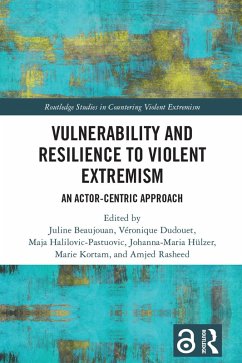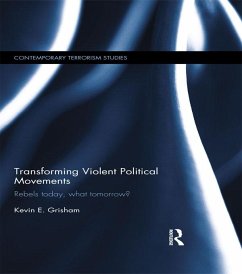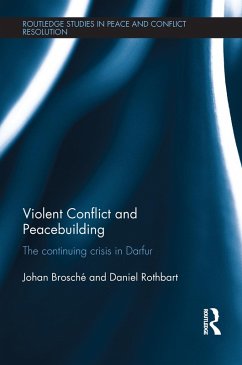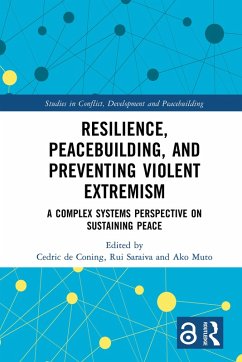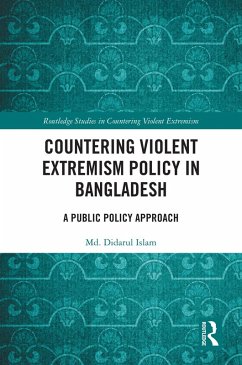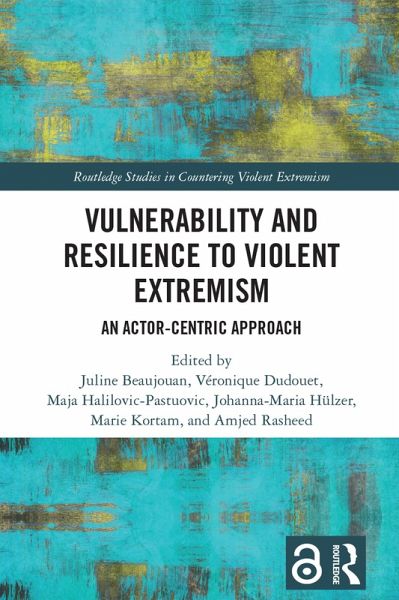
Vulnerability and Resilience to Violent Extremism (eBook, ePUB)
An Actor-Centric Approach
Redaktion: Beaujouan, Juline; Rasheed, Amjed; Kortam, Marie; Hülzer, Johanna-Maria; Halilovic-Pastuovic, Maja; Dudouet, Veronique

PAYBACK Punkte
0 °P sammeln!
This book examines the actors that shape societal dynamics leading to, or preventing, violent extremism from taking roots in their communities, including state representatives, religious institutions, and civil society actors.The volume contributes to an emerging stream of research focusing on intra- and inter-group dynamics to explain the emergence and persistence of, or resilience against, violent extremism. It utilises an actor-centric approach, uncovering the landscape of actors that play relevant roles in shaping societal dynamics leading to, or preventing, violent extremism affecting the...
This book examines the actors that shape societal dynamics leading to, or preventing, violent extremism from taking roots in their communities, including state representatives, religious institutions, and civil society actors.
The volume contributes to an emerging stream of research focusing on intra- and inter-group dynamics to explain the emergence and persistence of, or resilience against, violent extremism. It utilises an actor-centric approach, uncovering the landscape of actors that play relevant roles in shaping societal dynamics leading to, or preventing, violent extremism affecting their communities. The analysis builds on new empirical evidence collected in Bosnia and Herzegovina, Kosovo, North Macedonia, Serbia, Iraq, Lebanon, and Tunisia. This allows for an innovative comparative perspective on two regions in the European neighbourhood that are rarely studied together, even though they seem to share common patterns of (de-)radicalisation and violent extremism despite their distinct historical, political, and cultural trajectories and relations with the EU. In both regions, the book analyses the roles of and interactions between state, political, religious, and civil society actors in shaping community vulnerability to and/or resilience against violent extremism. Different types of community leaders are equipped with varying levels of authority, trust, legitimacy, and influence over community members. As such, the categories of actors analysed can play either detrimental or beneficial roles, which makes vulnerability and resilience to violent extremism two sides of the same coin.
This volume will be of much interest to students of countering violent extremism, terrorism, political violence, security studies, and International Relations generally.
The Open Access version of this book, available at www.taylorfrancis.com, has been made available under a Creative Commons Attribution (CC-BY) 4.0 International license.
The volume contributes to an emerging stream of research focusing on intra- and inter-group dynamics to explain the emergence and persistence of, or resilience against, violent extremism. It utilises an actor-centric approach, uncovering the landscape of actors that play relevant roles in shaping societal dynamics leading to, or preventing, violent extremism affecting their communities. The analysis builds on new empirical evidence collected in Bosnia and Herzegovina, Kosovo, North Macedonia, Serbia, Iraq, Lebanon, and Tunisia. This allows for an innovative comparative perspective on two regions in the European neighbourhood that are rarely studied together, even though they seem to share common patterns of (de-)radicalisation and violent extremism despite their distinct historical, political, and cultural trajectories and relations with the EU. In both regions, the book analyses the roles of and interactions between state, political, religious, and civil society actors in shaping community vulnerability to and/or resilience against violent extremism. Different types of community leaders are equipped with varying levels of authority, trust, legitimacy, and influence over community members. As such, the categories of actors analysed can play either detrimental or beneficial roles, which makes vulnerability and resilience to violent extremism two sides of the same coin.
This volume will be of much interest to students of countering violent extremism, terrorism, political violence, security studies, and International Relations generally.
The Open Access version of this book, available at www.taylorfrancis.com, has been made available under a Creative Commons Attribution (CC-BY) 4.0 International license.
Dieser Download kann aus rechtlichen Gründen nur mit Rechnungsadresse in A, B, BG, CY, CZ, D, DK, EW, E, FIN, F, GR, HR, H, IRL, I, LT, L, LR, M, NL, PL, P, R, S, SLO, SK ausgeliefert werden.




